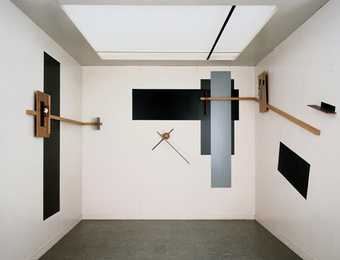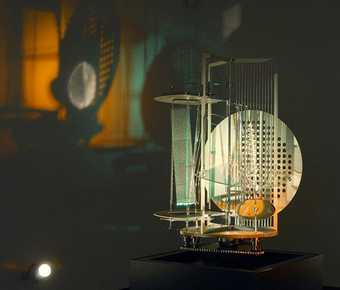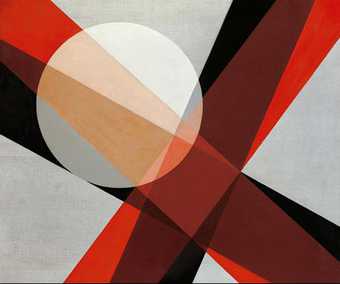For this workshop I would like to present three cases based on the collection of the Van Abbemuseum that – one way or another – deal with the notion of copyright and of the relationship of the replica to the artists’ original intentions. The first case is of a reconstruction that became an original, the second of a replica with a limited edition. The third case is that of a work which cannot be reproduced without losing its integrity.
1. El Lissitzky, Prounenraum 1923, reconstruction 1971

Fig.1
El Lissitzky
Prounenraum 1923, reconstruction 1971
Painted wood
320 x 364 x 364 cm
© DACS 2007
At the Grosse Berliner Kunstausstellung in 1923, Lissitzky was given the use of a small square space. Instead of hanging existing paintings, he decided to put new Proun compositions with reliefs on the walls, thus creating a three-dimensional Proun space. However, none of the elements of the exhibition were retained afterwards.
A reconstruction was made in 1965 by Jean Leering (director of the Van Abbemuseum 1964–73) for an exhibition of Lissitkzy’s work. It was based on a lithograph titled print nr.6, Proun Room from the 1e Kestnermappe Proun, 1923, that portrays the space in collapsed form; the painting Proun G.B.A., circa 1923, of an element from the Proun Room; and some photographs of the space. The reconstruction became part of the collection of the Van Abbemuseum and was lent out to several exhibitions in Europe. In 1970 Leering decided to make a second reconstruction, because the work was requested both for an exhibition in Paris and one at the Tate in London. He used the occasion to make some changes based on his intuitive reactions to the first version. However, this new reconstruction was never shown in the exhibition (Art in Revolution) in London, because the Russian government threatened to refuse their loans if the Proun Room was included. In 1995 Leering’s first reconstruction of the Proun Room was sold by the Van Abbemuseum to the Landesmuseum für Moderne Kunst, Architectur und Photographie in Berlin. The second version is still part of the collection of the Van Abbemuseum.
In 2003 the staff of the Van Abbemuseum considered building a new reconstruction for the opening of the new museum. We were forced to ask ourselves why we wanted a new reconstruction and what it would look like. At that moment it became clear that Leering’s interest in Lissitzky has become part of the history and context of the reconstruction. In addition to describing a lost work by the Russian artist, it now represents a part of the history of collecting.
2. László Moholy-Nagy, Licht-Raum Modulator, 1922/1930, replica 1970

Fig.2
László Moholy-Nagy
Licht-Raum Modulator 1922/1930, replica 1970
Metal, wood, glass, motor
201.7 x 78.8 x 69.7 cm
Hattula Moholy-Nagy / DACS 2007
In 1965 Jean Leering organised an exhibition called LichtKunstLicht (LightArtLight), which included the Licht-Raum Modulator of László Moholy-Nagy from the collection of the Busch-Reisinger Museum in Cambridge (Massachusetts). As the original did not function correctly (it was meant to turn on its axis projecting a light-and-shadow play on the adjacent walls), Leering suggested having a replica made. However, Sibyl Moholy-Nagy, the widow of László, preferred to have the original restored. Unfortunately, this restoration was unsuccessful, and the work was shown in Eindhoven as a static sculpture. Some years later Leering was informed that Sibyl Moholy-Nagy had agreed to the production of two replicas. The research and production was supervised by the wife of Otto Piene. Leering acted immediately and in 1970 was able to buy one of the replicas for the collection of the Van Abbemuseum. The other went to the collection of the Bauhaus Archive in Berlin. Owing to some changes (‘improvements’) to the original version, the replicas functioned as expected.
The replica in the Van Abbemuseum was lent to several exhibitions in Europe. By the 1990s it needed restoration because the motor was not functioning very well. Part of the research for this restoration involved contacting the Bauhaus Archive for information on their replica and it was interesting to see what decisions they had made concerning its restoration. Even their display of the work was different from the installation at the Van Abbemuseum.
In 2003 the Licht-Raum Modulator was installed ‘permanently’ in the galleries of the new Van Abbemuseum building. Like the Bauhaus Archive, the Van Abbemuseum decided not to lend the work for outside exhibitions owing to its fragility.
In 2005 the Van Abbemuseum received a loan request for the work from Tate Modern for the exhibition From the Bauhaus to the New World. The museum refused, as did the Bauhaus Archive who were also approached. Tate Modern then suggested building a new replica. The Moholy-Nagy Estate and the Busch-Reisinger Museum agreed, while the Van Abbemuseum agreed to the production of an exhibition copy that would be destroyed after the exhibition’s tour. Our position had to take into account the existence of a signed agreement between Hattula Rug (the daughter of Moholy-Nagy) and the Van Abbemuseum stipulating that there should be no more than two replicas.
Ultimately, the Tate suggested that they give their exhibition copy to the Busch-Reisinger Museum to use as an exhibition copy of their original, which was satisfactory for all parties.
3. Stanley Brouwn, 1 x 1 x 1 Step, 1995
The work consists of a multiplex cube, whose measurements are based on the length of one of the artist’s footsteps.
In his work, Stanley Brouwn often relates measurements from different regions of the world and from different moments in history to his own body measurements. His work can be considered as a measurement tool. Therefore, the dimensions of the work are very important and should be as precise as possible. The production of Brouwn’s works is undertaken by others, mostly commissioned craftsmen. In this way he excludes the ‘hand’ of the artist from the production process, and brings into question its status as a traditional work of art. However, this method also underlines the increased importance of the concept, context and intention of the work.
In the course of transportation for a touring exhibition this work was damaged. Owing to insufficient packing, the corners of the work were slightly dented, and there were also some scratches on the surface. It would have been possible to remove the damage by sanding, but that would have changed the size and therefore the essence of the work. The construction of a replica of the original was also unacceptable. For Brouwn, the issue is not only that the plywood used by the carpenter is part of the artwork, but also the actual time of production and the use of a particular measurement during the production process. Although in this case it would seem to be simple to make a material replica, it was incompatible with the concept of the work to do so.

